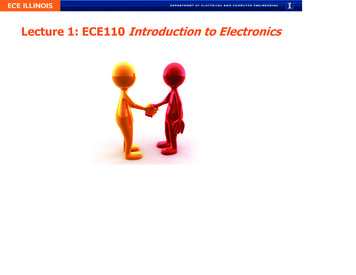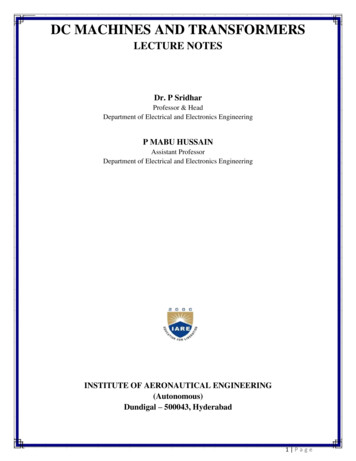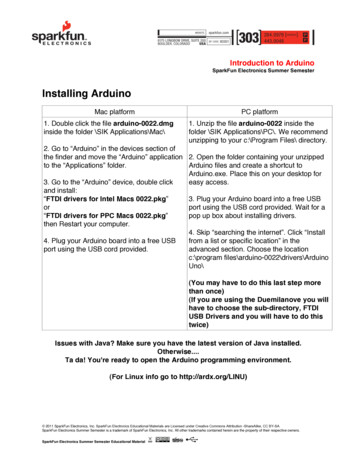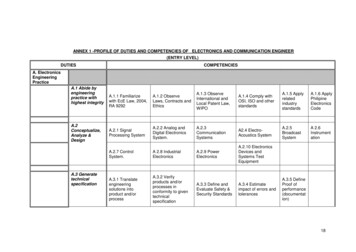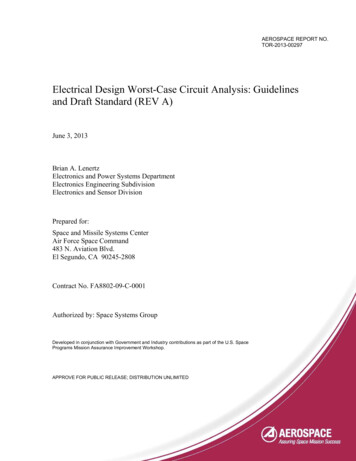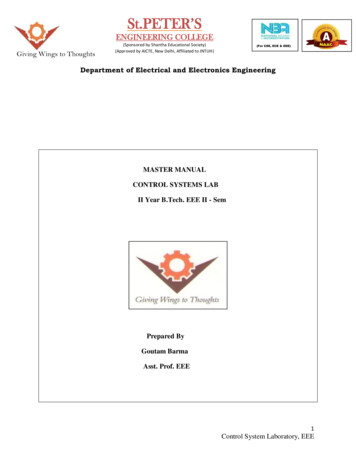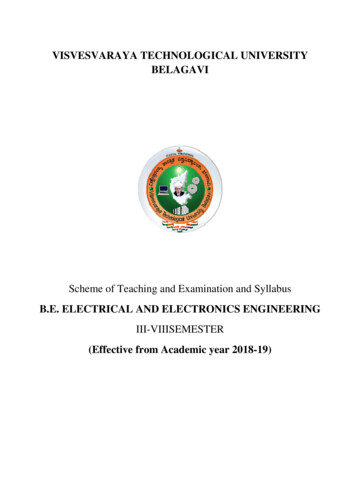
Transcription
VISVESVARAYA TECHNOLOGICAL UNIVERSITYBELAGAVIScheme of Teaching and Examination and SyllabusB.E. ELECTRICAL AND ELECTRONICS ENGINEERINGIII-VIIISEMESTER(Effective from Academic year 2018-19)
B. E. ELECTRICAL AND ELECTRONICS ENGINEERINGChoice Based Credit System (CBCS) and Outcome Based Education (OBE) and Outcome BasedEducation (OBE)SEMESTER - IIITRANSFORM CALCULUS, FOURIER SERIES AND NUMERICAL TECHNIQUES(Common to all Programmes)Course CodeCIE Marks4018MAT31Teaching Hours/Week (L: T:P)(2:2:0)SEE Marks60Credits03Exam Hours03Course Learning Objectives: To have an insight into Fourier series, Fourier transforms, Laplace transforms, Differenceequations and Z-transforms. To develop the proficiency in variational calculus and solving ODE’s arising in engineeringapplications, using numerical methods.Module-1Laplace Transform: Definition and Laplace transforms of elementary functions (statements only). Laplacetransforms of Periodic functions (statement only) and unit-step function – problems.Inverse Laplace Transform: Definition and problems, Convolution theorem to find the inverse Laplacetransforms (without Proof) and problems. Solution of linear differential equations using Laplace transforms.Module-2Fourier Series: Periodic functions, Dirichlet’s condition. Fourier series of periodic functions period 2π andarbitrary period. Half range Fourier series. Practical harmonic analysis.Module-3Fourier Transforms: Infinite Fourier transforms, Fourier sine and cosine transforms. Inverse Fouriertransforms. Problems.Difference Equations and Z-Transforms: Difference equations, basic definition, z-transform-definition,Standard z-transforms, Damping and shifting rules, initial value and final value theorems (without proof) andproblems, Inverse z-transform and applications to solve difference equations.Module-4Numerical Solutions of Ordinary Differential Equations(ODE’s):Numerical solution of ODE’s of first order and first degree- Taylor’s series method, Modified Euler’s method.Runge -Kutta method of fourth order, Milne’s and Adam-Bash forth predictor and corrector method (Noderivations of formulae)-Problems.Module-5Numerical Solution of Second Order ODE’s: Runge-Kutta method and Milne’s predictor and correctormethod. (No derivations of formulae).Calculus of Variations: Variation of function and functional, variational problems, Euler’s equation,Geodesics, hanging chain, problems.Course Outcomes: At the end of the course the student will be able to: CO1: Use Laplace transform and inverse Laplace transform in solving differential/ integral equationarising in network analysis, control systems and other fields of engineering. CO2: Demonstrate Fourier series to study the behaviour of periodic functions and their applications insystem communications, digital signal processing and field theory. CO3: Make use of Fourier transform and Z-transform to illustrate discrete/continuous function arisingin wave and heat propagation, signals and systems. CO4: Solve first and second order ordinary differential equations arising in engineering problemsusing single step and multistep numerical methods. CO5:Determine the externals of functionals using calculus of variations and solve problemsarising in dynamics of rigid bodies and vibrational analysis.Question paper pattern: The question paper will have ten full questions carrying equal marks. Each full question will be for 20 marks. There will be two full questions (with a maximum of four sub- questions) from each module. Each full question will have sub- question covering all the topics under a module. The students will have to answer five full questions, selecting one full question from each module.Sl.Name of theEditionandTitle of the BookName of the PublisherNo.Author/sYearTextbooks
12AdvancedEngineering E. KreyszigMathematicsHigher Engineering MathematicsB. S. Grewal3Engineering MathematicsSrimanta Pal et alReference Books1AdvancedEngineering C. Ray Wylie,MathematicsLouis C. Barrett2IntroductoryMethodsof S. S. SastryNumerical Analysis3Higher Engineering MathematicsB.V. Ramana4A Textbook of Engineering N. P. Bali andMathematicsManish Goyal5AdvancedEngineering Chandrika PrasadMathematicsand Reena GargWeb links and Video Lectures:1. http://nptel.ac.in/courses.php?disciplineID 1112. http://www.class-central.com/subject/math(MOOCs)3. http://academicearth.org/4. VTU EDUSAT PROGRAMME - 2010thEdition,2016Khanna Publishers44thEdition,2017OxfordUniversity 3rd Edition, 2016PressJohn Wiley & SonsMcGraw-Hill Book Co6th Edition, 1995Prentice Hall of India4th Edition 2010McGraw-HillLaxmi Publications11th Edition,20106th Edition, 2014Khanna Publishing,2018
B. E. ELECTRICAL AND ELECTRONICS ENGINEERINGChoice Based Credit System (CBCS) and Outcome Based Education (OBE)SEMESTER - IIIELECTRIC CIRCUIT ANALYSISCIE Marks40Course Code18EE32Teaching Hours/Week (L: T:P)(3:2:0)SEE Marks60Credits04Exam Hours03Course Learning Objectives: To familiarize the basic laws, source transformations, theorems and the methods of analyzing electricalcircuits. To explain the use of network theorems and the concept of resonance. To familiarize the analysis of three-phase circuits, two port networks and networks with non-sinusoidalinputs. To explain the importance of initial conditions, their evaluation and transient analysis of R-L and R-Ccircuits. To impart basic knowledge on network analysis using Laplace transforms.Module-1Basic Concepts: Active and passive elements, Concept of ideal and practical sources. Sourcetransformation and Source shifting, Concept of Super-Mesh and Super node analysis. Analysis ofnetworks by (i) Network reduction method including star – delta transformation, (ii) Mesh and Node voltagemethods for ac and DC circuits with independent and dependent sources. Duality.Module-2Network Theorems: Super Position theorem, Reciprocity theorem, Thevenin’s theorem, Norton’s theorem,Maximum power transfer theorem and Millman’s theorem. Analysis of networks, with and withoutdependent ac and DC sources.Module-3Resonant Circuits: Analysis of simple series RLC and parallel RLC circuits under resonances.Problems on Resonant frequency, Bandwidth and Quality factor at resonanceTransient Analysis: Transient analysis of RL and RC circuits under DC excitations: Behavior ofcircuit elements under switching action, Evaluation of initial conditions.Module-4Laplace Transformation: Laplace transformation (LT), LT of Impulse, Step, Ramp, Sinusoidal signalsand shifted functions. Waveform synthesis. Initial and Final value theorems.Module-5Unbalanced Three Phase Systems: Analysis of three phase systems, calculation of real and reactive Powersby direct application of mesh and nodal analysis.Two Port networks: Definition, Open circuit impedance, Short circuit admittance and Transmissionparameters and their evaluation for simple circuits, relationships between parameter sets.Course Outcomes: At the end of the course the student will be able to: Understand the basic concepts, basic laws and methods of analysis of DC and AC networks and reducethe complexity of network using source shifting, source transformation and network reduction usingtransformations. Solve complex electric circuits using network theorems. Discuss resonance in series and parallel circuits and also the importance of initial conditions and theirevaluation. Synthesize typical waveforms using Laplace transformation. Solve unbalanced three phase systems and also evaluate the performance of two port networks.Question paper pattern: The question paper will have ten questions. Each full question is for 20 marks. There will be 2 full questions (with a maximum of three sub questions in one full question) fromeach module. Each full question with sub questions will cover the contents under a module. Students will have to answer 5 full questions, selecting one full question from each module.Sl.Title of the BookNo.TextbooksNameofAuthor/stheName of the PublisherEditionYearand
1Engineering Circuit Analysis2Network Analysis3Fundamentals of ElectricCircuitsReference BooksEngineering Circuit Analysis1William H Hayt etalM.E.VanvalkenburgCharles KAlexanderMatthew N OSadikuMc Graw HillJ David Irwin et alWiley IndiaPearsonMc Graw Hill2Electric CircuitsMahmood NahviMc Graw Hill3Introduction to ElectricCircuitsCircuit Analysis; Theory andPracticeBasic Electrical EngineeringRichard C Dorf andJames A SvobodaAllan H RobbinsWilhelm C MillerV K Mehta, RohitMehtaWiley45CengageS 10th Edition,20145th Edition,20099th Edition,20155th Edition,20136th Edition 2015
B. E. ELECTRICAL AND ELECTRONICS ENGINEERINGChoice Based Credit System (CBCS) and Outcome Based Education (OBE)SEMESTER - IIITRANSFORMERS AND GENERATORSSubject Code18EE33CIE Marks40Number of Lecture Hours/Week3:0:0SEE Marks60(L:T:P)Credits03Exam Hours03Course Learning Objectives: To understand the concepts of transformers and their analysis. To suggest a suitable three phase transformer connection for a particular operation. To understand the concepts of generator and to evaluate their performance. To explain the requirement for the parallel operation of transformers and synchronous generators.Module-1Single phase Transformers: Operation of practical transformer under no-load and on-load with phasordiagrams. Open circuit and Short circuit tests, calculation of equivalent circuit parameters and predeterminationof efficiency-commercial and all-day efficiency. Voltage regulation and its significance.Three-phase Transformers: Introduction, Constructional features of three-phase transformers. Choice betweensingle unit three-phase transformer and a bank of three single-phase transformers. Transformer connection forthree phase operation– star/star, delta/delta, star/delta, zigzag/star and V/V, comparative features. Phaseconversion-Scott connection for three-phase to two-phase conversion. Labeling of three-phase transformerterminals, vector groups.Module-2Tests, Parallel Operation of Transformer& Auto Transformer: Polarity test, Sumpner’s test, separation ofhysteresis and eddy current lossesParallel Operation of Transformers: Necessity of Parallel operation, conditions for parallel operation– Singlephase and three phase. Load sharing in case of similar and dissimilar transformers. Auto transformers andTap changing transformers: Introduction to autotransformer-copper economy, equivalent circuit, no load andon load tap changing transformers.Module-3Three-Winding Transformers & Cooling of Transformers: Three-winding transformers. Cooling oftransformers.Direct current Generator: Armature reaction, Commutation and associated problems,Synchronous Generators: Armature windings, winding factors, e.m.f equation. Harmonics–causes, reductionand elimination. Armature reaction, Synchronous reactance, Equivalent circuit.Module-4Synchronous Generators Analysis: Alternator on load. Excitation control for constant terminal voltage.Voltage regulation. Open circuit and short circuit characteristics, Assessment of reactance-short circuit ratio,synchronous reactance, Voltage regulation by EMF, MMF and ZPFModule-5Synchronous Generators (Salient Pole): Effects of saliency, two-reaction theory, Parallel operation ofgenerators and load sharing. Methods of Synchronization, Synchronizing power, Determination of Xd & Xq –slip testPerformance of Synchronous Generators: Power angle characteristic (salient and non salient pole), powerangle diagram, reluctance power, Capability curve for large turbo generators. Hunting and damper windings.Course Outcomes: At the end of the course the student will be able to: Understand the construction and operation of 1-phase, 3-Phase transformers and Autotransformer. Analyze the performance of transformers by polarity test, Sumpner’s Test, phase conversion, 3-phaseconnection, and parallel operation. Understand the construction and working of AC and DC Generators. Analyze the performance of the AC Generators on infinite bus and parallel operation. Determine the regulation of AC Generator by Slip test, EMF, MMF, and ZPF Methods.
Question paper pattern: The question paper will have ten questions. Each full question is for 20 marks. There will be 2 full questions (with a maximum of three sub questions in one full question) fromeach module. Each full question with sub questions will cover the contents under a module. Students will have to answer 5 full questions, selecting one full question from each module.Text Books1Electric MachinesD. P. Kothari, et alMcGraw Hill 4th Edition, 20112Principals of Electrical Machines V.K Mehta, Rohit MehtaS Chand2nd edition, 2009Reference Books1st Edition, 20091Electric MachinesMulukuntlaS.Sarma,at el Cengage2Theodore WildiPearson6th Edition, 2014Electrical Machines, Drives andPower systemsElectric MachinesAshfaq Hussain3Dhanpat Rai 2nd Edition, 2013& Co
B. E. ELECTRICAL AND ELECTRONICS ENGINEERINGChoice Based Credit System (CBCS) and Outcome Based Education (OBE)SEMESTER - IIIANALOG ELECTRONIC CIRCUITSSubject Code18EE34CIE Marks40Number of Lecture Hours/Week2:2:0SEE Marks60(L:T:P)Credits03Exam Hours03Course Learning Objectives: Provide the knowledge for the analysis of diode and transistor circuits. Develop skills to design the electronic circuits like amplifiers and oscillators.Module-1Diode Circuits: Diode clipping and clamping circuits.Transistor Biasing and Stabilization: Operating point, analysis and design of fixed bias circuit, self- biascircuit, Emitter stabilized bias circuit, voltage divider bias circuit, stability factor of different biasingcircuits. Problems. Transistor switching circuits.Module-2Transistor at Low Frequencies: BJT transistor modelling, CE fixed bias configuration, voltage dividerbias, emitter follower, CB configuration, collector feedback configuration, analysis using h – parameter model,relation between h – parameters model of CE, CC and CB modes, Millers theorem and its dual.Module-3Multistage Amplifiers: Cascade and cascade connections, Darlington circuits, analysis and design.Feedback Amplifiers: Feedback concept, different types, practical feedback circuits, analysis and design offeedback circuits.Module-4Power Amplifiers: Amplifier types, analysis and design of different power amplifiers, Oscillators:Principle of operation, analysis and derivation of frequency of oscillation of phase shift oscillator, Wienbridge oscillator, RF and crystal oscillator and frequency stability.Module-5FETs: Construction, working and characteristics of JFET and MOSFET. Biasing of JFET and MOSFET.Analysis and design of JFET (only common source configuration with fixed bias) and MOSFET amplifiersCourse Outcomes: At the end of the course the student will be able to: Obtain the output characteristics of clipper and clamper circuits. Design and compare biasing circuits for transistor amplifiers & explain the transistor switching. Explain the concept of feedback, its types and design of feedback circuits Design and analyze the power amplifier circuits and oscillators for different frequencies. Design and analysis of FET and MOSFET amplifiers.Question paper pattern: The question paper will have ten questions. Each full question is for 20 marks. There will be 2 full questions (with a maximum of three sub questions in one full question)from each module. Each full question with sub questions will cover the contents under a module. Students will have to answer 5 full questions, selecting one full question from each module.Text Books1 Electronic Devices and CircuitTheoryRobert L BoylestadLouis Nashelsky2 Electronic Devices and CircuitsMillman and Halkias Mc Graw Hill4th Edition, 20153David A BellOxfordUniversity Press5th Edition, 2008Muhammad RashidCengage Learning 2nd Edition, 2014Electronic Devices and CircuitsReference Books1 Microelectronics CircuitsAnalysis and DesignPearson11th Edition, 2015
2345A Text Book of ElectricalTechnology, ElectronicDevices and CircuitsElectronic Devices and CircuitsB.L. Theraja,A.K. Theraja,Anil K. MainiVashaAgarvalS.SalivahananElectronic Devices and CircuitsN.SureshFundamentals of Analog Circuits Thomas L FloydS. ChandReprint, 2013Wiley1st Edition, 2009Mc Graw Hill3rd Edition, 2013Pearson2nd Edition, 2012
B. E. ELECTRICAL AND ELECTRONICS ENGINEERINGChoice Based Credit System (CBCS) and Outcome Based Education (OBE)SEMESTER - IIIDIGITAL SYSTEM DESIGNSubject CodeCIE Marks4018EE35Number of Lecture Hours/Week3:0:0SEE Marks60Credits03Exam Hours03Course Learning Objectives: Illustrate simplification of Algebraic equations using Karnaugh Maps and Quine- McCluskyTechniques. Design combinational logic circuits. Design Decoders, Encoders, Digital Multiplexer, Adders, Subtractors and Binary Comparators Describe Latches and Flip-flops, Registers and Counters. Analyze Mealy and Moore Models. Develop state diagrams, Synchronous Sequential Circuits and to understand the basics of variousMemories.Module-1Principles of Combinational Logic: Definition of combinational logic, canonical forms, Generationof switching equations from truth tables, Karnaugh maps-3,4,5 variables, Incompletely specifiedfunctions (Don‘t care terms) Simplifying Max term equations, Quine-McCluskey minimizationtechnique, Quine-McCluskey using don‘t care terms, Reduced prime implicants Tables.Module-2Analysis and Design of Combinational logic: General approach to combinational logic design,Decoders, BCD decoders, Encoders, digital multiplexers, Using multiplexers as Boolean functiongenerators, Adders and subtractors, Cascading full adders, Look ahead carry, Binary comparators.Module-3Flip-Flops: Basic Bistable elements, Latches, Timing considerations, The master-slave flip-flops (pulsetriggered flip-flops): SR flip-flops, JK flip-flops, Edge triggered flip- flops, Characteristic equations.Module – 4Flip-Flops Applications: Registers, binary ripple counters, synchronous binary counters, Counters basedon shift registers, Design of a synchronous counter, Design of a synchronous mod-n counter using clockedT, JK, D and SR flip-flops.Module – 5Sequential Circuit Design: Mealy and Moore models, State machine notation, Synchronous Sequentialcircuit analysis, Construction of state diagrams, counter design.Memories: Read only and Read/Write Memories, Programmable ROM, EPROM, Flash memory.Course Outcomes: After studying this course, students will be able to: Develop simplified switching equation using Karnaugh Maps and QuineMcClusky techniques. Design Multiplexer, Encoder, Decoder, Adder, Subtractors and Comparator as digitalcombinational control circuits. Design flip flops, counters, shift registers as sequential control circuits. Develop Mealy/Moore Models and state diagrams for the given clocked sequential circuits. Explain the functioning of Read only and Read/Write Memories, Programmable ROM, EPROMand Flash memory.Question paper pattern: The question paper will have ten questions. Each full question is for 20 marks. There will be 2 full questions (with a maximum of three sub questions in one fullquestion) from each module. Each full question with sub questions will cover the contents under a module. Students will have to answer 5 full questions, selecting one full question from each module.Text Books
1Digital Logic Applicationsand Design,John MYarbrough,2Digital Principles and DesignDonald D. GivoneReference Books1 Digital Circuits and DesignD. P. Kothari and J. SDhillon2Digital DesignMorris Mano3Fundamentals of logic designCharles H Roth, Jr.,ThomsonLearning2001ISBN 981240-062-1.McGraw Hill 2002 ISBN ntice Hall ThirdEditionof IndiaCengageFifth EditionLearning.
B. E. ELECTRICAL AND ELECTRONICS ENGINEERINGChoice Based Credit System (CBCS) and Outcome Based Education (OBE)SEMESTER - IIIELECTRICAL AND ELECTRONIC MEASUREMENTS (Core Course)Subject CodeCIE Marks4018EE36Number of Lecture Hours/Week (L:T:P) 3:0:0SEE Marks60Credits03Exam Hours03Course Learning Objectives: To measure resistance, inductance and capacitance using different bridges and determine earthresistance. To study the construction and working of various meters used for measurement. To study the adjustments, calibration & errors in energy meters and methods of extending the range ofinstruments.Module-1Measurement of Resistance: Wheatstone’s bridge, sensitivity, limitations. Kelvin’s double bridge.Earth resistance measurement by fall of potential method and by using Megger.Measurement of Inductance and Capacitance: Sources and detectors, Maxwell’s inductance and capacitancebridge, Hay’s bridge, Anderson’s bridge, Desauty’s bridge, S c h e r i n g bridge. Shielding of bridges. Problems.Module-2Measurement of Power, Energy, Power Factor and Frequency: Torque expression, Errors andminimization, UPF and LPF wattmeters. Measurement of real and reactive power in 3 phase circuits. Errors,adjustments and calibration of single and three phase energy meters, Problems. Construction and operation ofsingle-phase and three phase dynamometer type power factor meter. Weston frequency meter and phasesequence indicator.Module-3Extension of Instrument Ranges: Desirable features of ammeters and voltmeters. Shunts andmultipliers. Construction and theory of instrument transformers, Desirable characterises, Errors ofCT and PT. Turns compensation, Illustrative examples, Silsbee’s method of testing CT.Magnetic measurements: Introduction, measurement of flux/ flux density, magnetising force and leakage factor.Module-4Electronic and Digital Instruments: Introduction. Essentials of electronic instruments, Advantagesof electronic instruments. True rms reading voltmeter. Electronic multimeters. Digital voltmeters (DVM) - Ramptype DVM, Integrating type DVM and Successive - approximation DVM. Q meter. Principle of working ofelectronic energy meter (with block diagram), extra features offered by present day meters and theirsignificance in billing.Module-5Display Devices: Introduction, character formats, segment displays, Dot matrix displays, Bar graphdisplays. Cathode ray tubes, Light emitting diodes, Liquid crystal displays, Nixes, Incandescent, Fluorescent,Liquid vapour and Visual displays.Recording Devices: Introduction, Strip chart recorders, Galvanometer recorders, Null balance recorders,Potentiometer type recorders, Bridge type recorders, LVDT type recorders, Circular chartand recorders. Digital tape recording, Ultraviolet recorders. Electro Cardio Graph (ECG)Course Outcomes: At the end of the course the student will be able to: Measure resistance, inductance and capacitance using bridges and determine earth resistance. Explain the working of various meters used for measurement of Power, Energy & understand theadjustments, calibration & errors in energy meters. Understand methods of extending the range of instruments & instrument transformers. Explain the working of different electronic instruments. Explain the working of different display and recording devices.
Question paper pattern: The question paper will have ten questions. Each full question is for 20 marks. There will be 2 full questions (with a maximum of three sub questions in one full question) fromeach module. Each full question with sub questions will cover the contents under a module. Students will have to answer 5 full questions, selecting one full question from each module.Text Books1Electrical and electronic MeasurementsA.K. SawhneyDhanpat Rai10th Editionandand Co2InstrumentationACourse in Electronics and ElectricalJ. B. GuptaKatson Books2013 EditionMeasurements and InstrumentationReference Books12345Electrical and electronic MeasurementsandInstrumentationElectricalMeasuring Instruments andMeasurementsModern Electronic Instrumentation andMeasuring TechniquesElectronic Instrumentation andMeasurementsElectronic InstrumentationR.K. RajputS ChandS.C. BhargavaBS Publications 2013Cooper D andA.D. HeifrickDavid A BellPearsonFirst Edition, 2015OxfordUniversityMc Graw Hill3rd Edition, 2013H.S.Kalsi5th Edition, 20123rd Edition,2010
B. E. ELECTRICAL AND ELECTRONICS ENGINEERINGChoice Based Credit System (CBCS) and Outcome Based Education (OBE)SEMESTER - IIIELECTRICAL MACHINES LABORATORY - 1Subject Code18EEL37CIE Marks40Number of Practical Hours/Week0:2:2SEE Marks60Credits02Exam Hours03Course Learning Objectives: Conducting of different tests on transformers and synchronous machines and evaluation of theirperformance. Verify the parallel operation of two single phase transformers. Study the connection of single phase transformers for three phase operation and phase conversion. Study of synchronous generator connected to infinite bus.Sl.No.123456789101112ExperimentsOpen Circuit and Short circuit tests on single phase step up or step down transformer and predetermination of (i) Efficiency and regulation (ii) Calculation of parameters of equivalent circuit.Sumpner’s test on similar transformers and determination of combined and individual transformerefficiency.Parallel operation of two dissimilar single-phase transformers of different kVA and determination ofloadsharingverificationgiven the Shortcircuit testPolarity andtest analyticaland connectionof 3 single-phasetransformersin data.star – delta and determination ofefficiency and regulation under balanced resistive load.Comparison of performance of 3 single-phase transformers in delta – delta and V – V (open delta)connection under load.Scott connection with balanced and unbalanced loads.Separation of hysteresis and eddy current losses in single phase transformer.Voltage regulation of an alternator by EMF and MMF methods.Voltage regulation of an alternator by ZPF method.Power angle curve of synchronous generator or Direct load test on three phase synchrousgenerator to determine efficiency and regulationSlip test – Measurement of direct and quadrature axis reactance and predetermination ofregulation of salient pole synchronous machines.Performance of synchronous generator connected to infinite bus, under constant power and variableexcitation & vice - versa.Course Outcomes: At the end of the course the student will be able to: Evaluate the performance of transformers from the test data obtained. Connect and operate two single phase transformers of different KVA rating in parallel. Connect single phase transformers for three phase operation and phase conversion. Compute the voltage regulation of synchronous generator using the test data obtained in thelaboratory. Evaluate the performance of synchronous generators from the test data and assess theperformance of synchronous generator connected to infinite bus.Conduct of Practical Examination:1. All laboratory experiments are to be included for practical examination.2. Breakup of marks and the instructions printed on the cover page of answer script to be strictly adheredby the examiners.3. Students can pick one experiment from the questions lot prepared by the examiners.4. Change of experiment is allowed only once and 15% Marks allotted to the procedure part to be made zero.
B. E. ELECTRICAL AND ELECTRONICS ENGINEERINGChoice Based Credit System (CBCS) and Outcome Based Education (OBE)SEMESTER - IIIELECTRONICS LABORATORYSubject Code18EEL38CIE Marks40Number of Practical Hours/Week 0:2:0SEE Marks60Exam Hours03Credits02Course Learning Objectives: To design and test half wave and full wave rectifier circuits. To design and test different amplifier and oscillator circuits using BJT. To study the simplification of Boolean expressions using logic gates. To realize different Adders and Subtractors circuits. To design and test counters and sequence generators.Sl.No1ExperimentsDesign and Testing of Full wave – centre tapped transformer type and Bridge type rectifiercircuits with and without Capacitor filter. Determination of ripple factor, regulation and efficiency.23Static Transistor characteristics for CE, CB and CC modes and determination of h parameters.Frequency response of single stage BJT and FET RC coupled amplifier and determination of halfpower points, bandwidth, input and output impedances.4Design and testing of BJT -RC phase shift oscillator for given frequency of oscillation.5Determination of gain, input and output impedance of BJT Darlington emitter follower with andwithout bootstrapping.6Simplification, realization of Boolean expressions using logic gates/Universal gates.7Realization of Half/Full adder and Half/Full Subtractors using logic gates.8Realization of parallel adder/Subtractors using 7483 chip- BCD to Excess-3 code conversion andVice - Versa.9Realization of Binary to Gray code conversion and vice versa.10Design and testing Ring counter/Johnson counter.11Design and testing of Sequence generator.12Realization of 3 bit counters as a sequential circuit and MOD – N counter design using 7476, 7490,74192,*Note: A minimum of three experiments to be simulated using (Freeware Software Package)Course Outcomes: At the end of the course the student will be able to: Design and test rectifier circuits with and without capacitor filters. Determine h-parameter models of transistor for all modes. Design and test BJT and FET amplifier and oscillator circuits. Realize Boolean expressions, adders and subtractors using gates. Design and test Ring counter/Johnson counter, Sequence generator and 3 bit counters.Conduct of Practical Examination:1. All laboratory experiments are to be included for practical examination.2. Breakup of marks and the instructions printed on the cover page of answer script to be strictly adhered bythe examiners.3. Students can pick one experiment from the questions lot prepared by the examiners.4. Change of experiment is allowed only once and 15% Marks allotted to the procedure part to be made zero.
B. E. (Common to all Programmes)Outcome Based Education (OBE) and Choice Based Credit System (CBCS)SEMESTER –II / III / IVAadalitha KannadaCourse Code18KAK28/39/49Teaching Hours/Week (L:T:P)(0:2:0)CIE MarksC
1 Engineering Circuit Analysis Will iam H Hayt et al Mc Graw Hill 8th Editi on,2014 2 Network Analysis M.E. Vanval kenburg Pearson 3rd Editi on,20 14 . 5 Basic Electr ical Engineering thV K Mehta, Rohit Me hta S Chand 6 Edition 2015 . B. E. ELECTRICAL AND ELECTRONICS ENGINEERING




